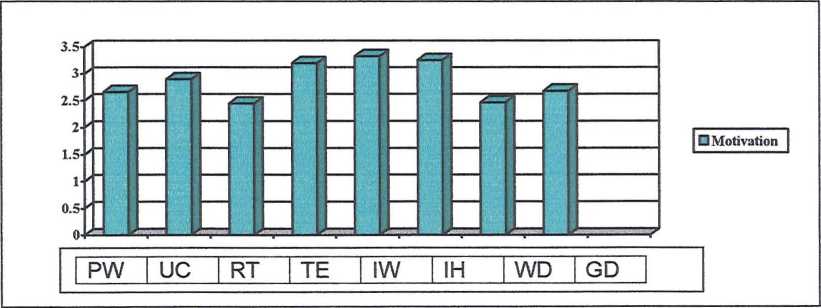114
Motivation
In relation to motivation, Table 4.1.20 and Figure 4.1.17 below show that 8th graders
neither agreed nor disagreed (3≤M<4) that Teacher explanation, Individual work, and
Individual help promoted their motivation. They disagreed (2≤M<3) that Practical work,
Using a computer, Reading a textbook, Whole-class discussion and Group discussion
promoted motivation. These findings were statistically significant. A relatively wide
distribution existed in the extent to which their motivation to learn mathematics was
perceived to be promoted by different teaching methods. While 8th graders did not feel
that any teaching method actually promoted motivation, those, which were perceived as
the least negative were the ones reported as most frequently deployed by the teachers
of 8th graders: Teacher explanation, Individual work and Individual help.
Table 4.1.20: Mean scores and Standard Deviation; motivation; perceptions of 8th
graders
|
Practical |
Using |
Reading a |
Teacher |
Individual |
Individual |
Whole-class |
Group | |
|
N |
2149 |
2147 |
2142 |
2148 |
2148 |
2149 |
2149 |
2148 |
|
M |
2.66 |
2.90 |
2.45 |
3.20 |
3.33 |
3.26 |
2.47 |
2.68 |
|
SD |
1.29 |
1.39________ |
1.17 |
1.22__ |
1.29 |
1.35________ |
1.19 |
1.28________ |
The result ofa repeated measure ANOVA [F (8, 17096)=197.43, p<. 01]
Figure 4.1.17: Motivation promoted by different teaching methods; perceptions of 8th
graders

114
More intriguing information
1. Financial Development and Sectoral Output Growth in 19th Century Germany2. Contribution of Economics to Design of Sustainable Cattle Breeding Programs in Eastern Africa: A Choice Experiment Approach
3. Infrastructure Investment in Network Industries: The Role of Incentive Regulation and Regulatory Independence
4. Regionale Wachstumseffekte der GRW-Förderung? Eine räumlich-ökonometrische Analyse auf Basis deutscher Arbeitsmarktregionen
5. The name is absent
6. The name is absent
7. fMRI Investigation of Cortical and Subcortical Networks in the Learning of Abstract and Effector-Specific Representations of Motor Sequences
8. An Estimated DSGE Model of the Indian Economy.
9. Benefits of travel time savings for freight transportation : beyond the costs
10. Work Rich, Time Poor? Time-Use of Women and Men in Ireland